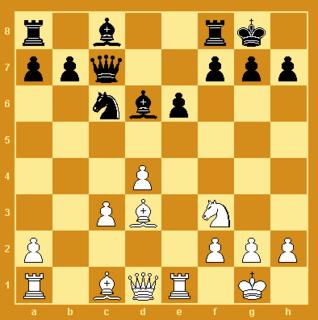
I was thinking about a game I read about once in an old Australian chess magazine where an unknown player from South-East Asia somewhere beat a well-known Australian player or master from some well-established chess country. I thought the country was Vietnam, Thailand, or Hong Kong. So I downloaded SCID a chess database, installed in on my Powerbook, and downloaded all the Olympiad games from Olimpbase. I didn't find the game, but searching for "VIE" I did come across the game Ochoa de Echagüen (2450) vs McLeod at Thessaloniki 1988.
1.e4 c6 2.c4 d5 3.cxd5 cxd5 4.exd5 Nf6 5.Nc3 Nxd5 6.Nf3 Nxc3 7.bxc3 Nc6 8. d4 e6 9.Bd3 Qc7 10.O-O Bd6 11.Re1 O-O 12.Qe2 Ne7 13.c4 b6 14.Bd2 Bb7 15. Bxh7+ Kxh7 16.Ng5+ Kg8 17.Qh5 Bxh2+ 18.Kh1 1-0
I wondered whether Bxh7+ would have been possible on a previous move (diagram shows position
before White's 12th move).
After 12. Bxh7+ Kxh7 13. Ng5+, then 13... Kg8? 14. Qh5 Re8 15. Qh7+ Kf8 16. Ne4 is very good for White, but 13... Kg6 14. h4 Rh8 15. Qd3+ f5 allows black to defend.
13. Bxh7+ Kxh7 14. Ng5+ Kg6 15. h4 Rh8 16. Qe4+ Nf5 17. g4 Rxh4 18. gxf5+ Kh5 19. Qf3+ Rg4+ 20. Kh1 exf5 and Black is hanging on.
But, because the Black rook on a8 is a loose piece after 13...b6?, it does work on the next move. 14. Bxh7+ Kxh7 15. Ng5+ Kg6 15. h4 Rh8 16. Qe4+ Nf5 17. g4 and then if 17... Rxh4? 18. gxf5+ and 19. Qxa8 wins. So it was best to play it on move 14. I don't know what White had in mind after 16... Kg6 17. Qg4 f5!.

